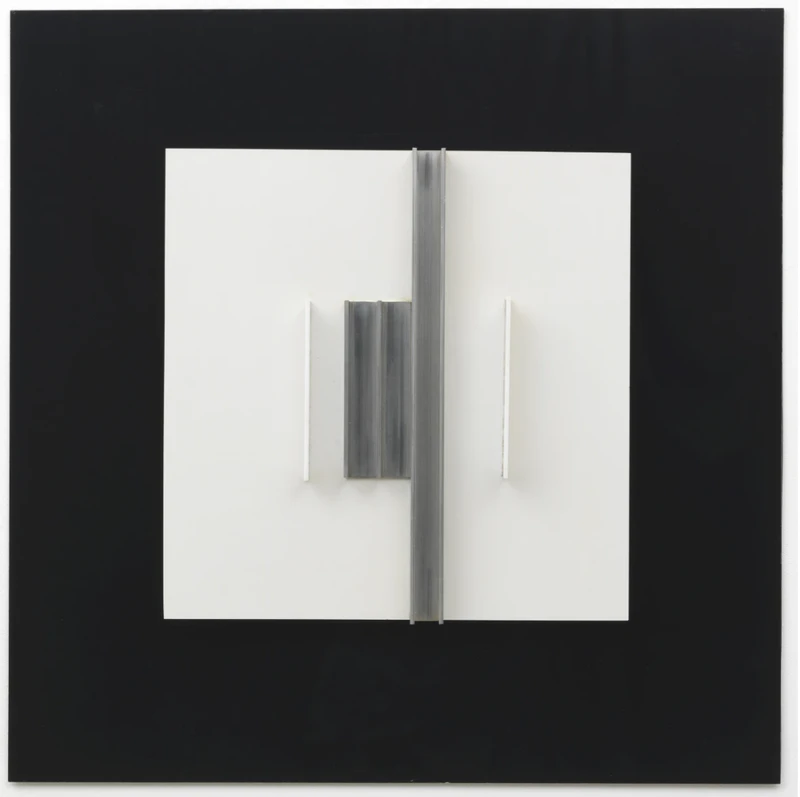Anthony Hill: 5 Decades
18 May-8 Jul 2023


‘I support anarchic and iconoclastic ventures in art, they complement the constructive which left by itself can all too easily become either impotent altruism or – worse by far – academicism.’
Anthony Hill, ‘A and non-A: A lecture’, in ‘Uncovered Redo’, 1979
Annely Juda Fine Art is delighted to announce the upcoming exhibition: Anthony Hill, 5 Decades. This is the first solo exhibition of the artist’s work at the gallery and his first in 20 years. It includes both his signature relief constructions and collage works by his Dadaist alter ego, Redo. The exhibition will be across two floors and will run from 18th May – 8th July 2023.
Anthony Hill (1930–2020) was a seminal figure in British art. He was a founding member and principal theorist of the Constructionists, a group promoting the new post-war abstraction, centred around Victor Pasmore. By the mid-1950s he had abandoned painting for relief construction. Embracing Duchamp’s idea of the readymade, Hill used industrial materials such as copper, aluminium and perspex to propose a radical view of structure in art. He featured in the group exhibition This is Tomorrow at the Whitechapel Gallery, London, in 1956, had his first solo exhibition at the Institute of Contemporary Art, London, in January 1958, and participated in Max Bill’s Konkrete Kunst exhibition in Zurich in 1960, exhibiting in survey shows worldwide thereafter. In 1983 he had a major retrospective at the Hayward Gallery, London.
In the early 1970s Hill began to push against the dogma surrounding constructivism, starting to make Dada-inspired work alongside the abstract art for which he was well known. An alter ego was born, introduced as Rembrandt Doxford, a name which soon became shortened to Redo (pronounced ray-dough). At first Redo worked in collage, using imagery in ways inspired by John Heartfield and Max Ernst, before moving into three dimensions in the 1980s with constructed works that married the syntax of Hill’s reliefs with an array of found and recycled materials. For Hill the idea of an alter ego was rooted in the early part of the twentieth century, influenced by Duchamp with Rrose Sélavy, and Van Doesburg with I.K. Bonset. In fact collage and juxtaposition had been a preoccupation of Hill’s from the start; as he noted later, ‘the Dada streak in A.H. was never exorcised…’.
The contrast between the works of Hill and Redo reveals a complex artist of many facets and influences but with a stronger common thread than one might initially think. Redo’s raw materials were mostly detritus found within a mile or so of Hill’s studio on Charlotte Street, London: discarded X-rays from the nearby hospital, flotsam from the advertising agencies in the area, expired materials from the constant refurbishments in the streets of Fitzrovia. But Hill saw no distinction between this and the use of readymade elements in his constructivist work, only that in Redo’s work the industrial materials would be found rather than specified.
Parallel to his art, Hill’s inquiries took him into the field of topology, a branch of mathematics concerned with pure structure. In 1963 he published Hill’s Conjecture, a discovery for which he is well known among mathematicians. But he was adamant that he was not a ‘mathematical’ artist; to search for mathematical content in his reliefs to overlook their intensely poetic, intuitive nature.
Hill’s reclusiveness in later years left him in the curious position of being deeply admired yet not as widely recognised as the importance of his work would suggest. His art was radical and uncompromising from the beginning, and he held to his beliefs throughout the waves of fashion and acceptance. As Nicholas Serota, former Director of the Tate, states:
“Anthony Hill played a remarkable part in the history of modernism in England after the Second World War. His work, his writing and his engagement with intellectual endeavour in Europe and America changed the way that art developed in London, moving the terms of reference beyond Paris without falling under the spell of New York. I had a deep respect for his achievements.”
—Nicholas Serota
Hill died in 2020. He was a unique and significant figure in British art. A catalogue raisonné and an extended monograph are in preparation, as well as a collection of his writings and interviews. Hill’s Conjecture is still an open problem and the subject of intense study among mathematicians worldwide. His archive includes extensive correspondence with Duchamp, Georges Vantongerloo, Charles Biederman, LEJ Brouwer and Pasmore, among many others. His work is part of public collections internationally including several of his most significant constructions in the permanent collection of the Tate.